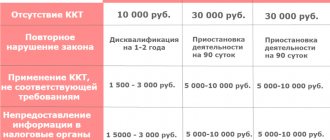Explaining the term
This is the application of a personal symbol, which has a graphic image and a number, to the surface of the container, packaging or the “body” of the product itself. Features of use:
- Each code is unique - there are no two identical codes in the form of KIZ or simply printed “DataMatrix”.
- When an object is taken out of circulation, the digital designation is not reused.
At the moment, not all products are required to undergo this procedure, however, many brands are already taking part in trial projects. It is expected that labeling of products and products will soon be mandatory, but now not even all manufacturers know what it is.
https://youtu.be/ERThpb4BXi4
Business Solutions
- shops clothing, shoes, groceries, toys, cosmetics, appliances Read more
- warehouses
material, in-production, sales and transport organizations Read more
- marking
tobacco, shoes, consumer goods, medicines Read more
- production
meat, procurement, machining, assembly and installation Read more
- rfid
radio frequency identification of inventory items More details
- egais
automation of accounting operations with alcoholic beverages Read more
Why is labeling needed?
The main objective of the new bill is protection against counterfeit products. Counterfeits are entering the Russian market en masse. This trend can be seen in many areas, but the most dangerous phenomenon is in the production of medicines, as well as in the food industry and alcohol production.
The lack of control and requirements from government agencies leads to mass poisonings, as well as violation of copyright and intellectual rights. For the country, the negative factors are the following:
- such manufacturers are not included in registers, they do not pay taxes;
- there is no way to control the turnover of products;
- When working with chemicals, harm to the public may occur.
Product labeling helps consumers avoid problems associated with counterfeit products:
- low quality products;
- possibility of poisoning;
- lack of guarantees and certificates.
All these problems led to the idea of controlling all trade turnover. The first codes appeared in 2005; they were assigned only to alcohol. This helped reduce the number of counterfeits by 20%. A similar procedure must now be carried out for other categories of items and products. These will be medicines, alcohol and tobacco.
It is obvious that mandatory labeling with identification means is a necessity for manufacturers. But it also becomes easier for buyers to find out all the detailed information about the purchase. To do this, you need to have a smartphone with a camera and the “Product Check” utility installed there. It helps you scan the code and gives an instant response. The common database used by the software is filled with information about each new batch as soon as it leaves the assembly line at the factory.
How the system works
There is an organization that records and tracks each product item. There are now three different resources for alcohol, drugs and fur coats, each with a narrow profile. But from 2020, in accordance with the law and rules on mandatory labeling of goods or products, all manufactured products (except for alcohol, which is taken into account in the Unified State Automated Information System) will have a code that is taken into account in the CRPT. Nowadays cigarettes are recorded in this center.
So every entrepreneur should register for free in these systems. Not only those who produce products are required to fill out reports for each unit, but also suppliers and sellers. Anyone with access to tracking can find out by a unique code where the item is now - whether it came off the assembly line at the factory, in the warehouse, on the way during transportation, on sale or has already been sold.
The KIZ is not invented by the manufacturer himself. He makes a request to CRPT (or, for example, EGAIS for alcoholic beverages), and the system itself generates the code. While everything is happening on a voluntary basis, you can get free numbers, but with the introduction and approval of the list of goods subject to mandatory labeling with identification means in Russia, you will have to pay for them, so costs will increase, and along with the cost of production, the final cost will also increase.
When the code is received, it is applied to the packaging. At the same time, lots of items that need to be labeled, but this is not done, cannot be put up for sale. An attempt to bypass the system will be punishable by fines and suspension of activities (administrative liability), and in some cases, prison.
As a conclusion, we will answer the question “Who should label the product?” Labeling occurs once by the manufacturer or importer. Other legal entities are required to relabel in order to provide data on turnover.
Assigning a digital marking code to goods
Before a product can be sold, it must be assigned a digital marking code. The manufacturer, importer or exporter of the product is responsible for applying the code to the packaging of the product. If the manufacturer is foreign, then the digital code is applied by the importer before going through customs procedures.
In the case of shoes, for example, a labeling code is affixed to each box. This, in particular, means that wholesale importers will have to process each pair of shoes separately.
Importers or manufacturers must obtain the codes before printing labels with labeling codes. This can be done at the Center for the Development of Advanced Technologies (CDPT). Only CRPT is authorized by the state to perform this operation.
An example of a marking code is shown in Fig. 1.
Rice. 1. Example of marking code
What is encoded here?
The DataMatrix barcode contains the following information:
- Global Trade Item Number (GTIN) in the GS1 Automatic Identification Association catalog (the first 14 digits are highlighted in red in our figure);
- individual serial number of the product (14 digits, highlighted in blue);
- the first 4 digits of the 10-digit customs identifier code of the EAEU TD VED (highlighted in green);
- 4 character verification key (contained in the DataMatrix barcode);
- 88 characters of electronic signature (contained in the DataMatrix barcode)
The GTIN number, individual serial number of the product and the first 4 digits of the EAEU TD VED are duplicated by numbers under the DataMatrix barcode. As for the verification key and electronic signature, this information is only in the barcode.
Manufacturers and importers can obtain a GTIN for their goods by joining the Automatic Identification Association “UNISKAN/GS1 RUS” (GS1 RUS). The terms of membership indicate that for participants of mandatory labeling there is a discount of 3,000 rubles. entrance fee and 3000 rub. annual contribution starting from the year following entry into force.
It should be noted that even if you do not manufacture or import goods, but only sell them, you may still need GTIN codes for the purpose of labeling (re-labeling) goods or their balances. In this case, you will need to print out stickers with codes and attach them to the product packaging.
List of products that must be tracked
Only new units will have KIZs. It has not yet been decided what to do with used products that are actively sold on various sites. The law is just coming into effect now. But there are two categories (alcohol and furs) that are already actively entered into the register during production.
Table: which products are subject to labeling
| Product name | Voluntarily | Necessarily |
| Fur coats | From 2020 | |
| Alcohol-containing drinks | From 2020 | |
| Medicines | From 2020 | No data |
| Jewelry | Pilot version – from June to November 2020 | No data |
| Tobacco | From January to December 1, 2018 | From July 1, 2019 |
| Shoes | From June to December 1, 2018 | From July 1, 2019 |
| Perfume industry | From 01.12.19 | |
| Any outerwear | From 01.12.19 | |
| Car (and other vehicles) wheels, tires, tires | From 01.12.19 | |
| Any wardrobe items made of genuine leather, suede - wallets, bags, belts | From 01.12.19 | |
| Women's blouses | From 01.12.19 | |
| Photographic equipment | From 01.12.19 |
The list of labeled goods is plans that have not yet been implemented. This list is incomplete and will be updated depending on the successful progress of the project with the specified units. Consumers need to be prepared for a slight increase in prices for these products.
Use of markings in online stores
In connection with the imminent mandatory use of labeling, all store owners have numerous questions. We will try to answer the most important of them, and also provide links to the necessary sites and documents.
What products are subject to labeling and in what timeframes must you start using product labeling?
Decree of the Government of the Russian Federation No. 791-r dated April 28, 2020 approved the list of the first 10 product groups that are subject to mandatory labeling from December 1, 2019 (tobacco products must be labeled from March 1, 2020):
- Tobacco products
- Perfume and eau de toilette
- New pneumatic rubber tires and tires
- Articles of clothing, including work clothing, made from leather or composition leather
- Blouses, blouses and blouses, knitted by machine or hand knitting, for women or girls
- Coats, short coats, capes, raincoats, jackets (including ski jackets), windbreakers, windbreakers and similar articles for men or boys
- Coats, short coats, capes, raincoats, jackets (including ski jackets), windbreakers, windbreakers and similar items for women or girls
- Bed, table, toilet and kitchen linen
- Shoe products
- Cameras (except film cameras), flash units and flash lamps
All medicines will be subject to labeling from January 1, 2020. And starting from 2024, goods from all industries will be subject to labeling.
As you can see, the list of goods that need to be labeled starting this year is quite extensive. If your business involves the sale or delivery of these products, you need to start preparing for the use of labeling now.
What to do with the remains of unlabeled goods after the deadline for mandatory use of labeling has expired
Currently, you may only receive unlabeled products from suppliers. However, over time, the circulation of unlabeled products in the Russian Federation will be prohibited, while for violators of Art. 15.12 of the Code of Administrative Offenses provides for quite significant fines with confiscation of unlabeled products. For individual entrepreneurs this can be fines of 5,000-10,000 rubles, for legal entities - from 50,000 to 300,000 rubles.
If by the time the circulation of unmarked products is prohibited you have leftovers in your warehouse, then in order to sell them without breaking the law, you will have to label all copies of the goods yourself.
According to the draft resolution on approval of the Rules for Labeling Footwear Products, from March 1, 2020, the production, import, retail trade and circulation of unmarked shoes is prohibited. Between October 1, 2020 and March 1, 2020, balances must be marked.
There will be similar requirements for goods from other groups. In any case, you will need to either sell off unmarked balances while the law allows it, or if you do not have time to do this within the allotted time, label the balance yourself.
How an online store or retail store should accept labeled products from suppliers
During the acceptance process, it is necessary to compare the marking codes of all accepted copies of goods with the data of the supplier’s documents.
It is important that you cannot use paper documents for acceptance and shipment of marked goods, as was the case before. Now electronic document management (EDF) will be required.
The EDI system allows you to exchange legally significant electronic documents, including such as a universal transfer document (UDD) containing product labeling codes. To use EDF, you must purchase a qualified electronic signature certificate.
Acceptance and signing of documents received through EDF is free. However, you will have to pay for sending documents, but not much. This may cost you less than sending paper documents by mail. As a result, when using EDI, the time for exchanging documents and the costs of printing and mailing paper documents are reduced.
Using a qualified electronic signature certificate, you can, in particular, remotely register cash register equipment on the Federal Tax Service website. This equipment will also be needed to sell labeled goods, which we will talk about later.
There are quite a few EDF operators; you can look at their list, for example, on the Federal Tax Service website, and choose the operator that is most suitable for you.
Thus, in the process of accepting marked products, an electronic UPD is generated, in which for each instance of the accepted product its marking code is recorded. This code will need to be read from the sticker using a scanner that can recognize barcodes in the DataMatrix standard.
How an online store or retail store should sell labeled products to the end consumer
When a retail store sells a product to the end consumer, the cashier must read the label code and enter it into the cash register program. When generating an electronic receipt, a list of all items included in it will be created, and for each product to be marked, the required code will be added to the receipt.
The generated receipt with marking codes is transferred by the cash register to the fiscal data operator (FDO), after which the marking codes of the goods sold are removed from circulation.
In order for your cash register to process marking codes, you may need to update its firmware. Also, to process marking codes, you will need to enter into an additional agreement with the OFD. Some OFDs charge a separate fee for this, so compare the offers of different OFDs.
In an online store, the business process for processing marking codes is slightly different. Here, processing of marking codes should occur at the stage of order formation and transfer to the end consumer.
If the buyer has accepted the goods, then an electronic receipt is sent to him, and this receipt must contain the marking codes of all copies of the product. At the time of payment, you need to send an electronic receipt to the OFD, however, the labeling codes for the goods sold may not yet be known at this stage. For example, a product can be delivered to order, or it can be delivered after some time from a warehouse.
How to be?
The solution is to use two checks. The first check (for prepayment) is sent when money is received and does not contain marking codes. The second receipt is issued at the time of receipt of the goods and the marking codes are already indicated in it.
A similar scenario with two receipts can be used for dropshipping. In any case, the company that delivers the goods to the end consumer must send a receipt with marking codes.
When a product is delivered by a courier service, this service issues a receipt with marking codes. And if the courier service acts as a paying agent and receives money from the buyer at the time of delivery, then it punches the receipt with both payment data and marking codes.
What to do if the buyer returns the goods, if the labeling is damaged or some other unusual situation arises
In real life, many different situations can arise when selling goods. For example, the buyer can return the order in whole or in part. He can return the goods when the packaging is intact, but the labeling code is not readable by the scanner.
How to act in such situations?
If the sticker with the code is not damaged, then the product can be returned to circulation by sending data about the product, the operation and its participants, as well as documents related to the operation, to the CRPT. In the event that the scanner cannot read the sticker, you will have to re-label the product.
A detailed description of actions in various cases when selling shoes can be found in the document Methodological recommendations for participants in the experiment on labeling with identification means and monitoring the turnover of footwear products. On the website honestznak.rf you can find similar recommendations for other types of goods that are subject to labeling.
Business Solutions
- the shops
clothes, shoes, products, toys, cosmetics, appliances Read more
- warehouses
material, in-production, sales and transport organizations Read more
- marking
tobacco, shoes, consumer goods, medicines Read more
- production
meat, procurement, machining, assembly and installation Read more
- rfid
radio frequency identification of inventory items More details
- egais
automation of accounting operations with alcoholic beverages Read more
What law governs the program?
Federal Law No. 487 was adopted at the end of 2020 and came into force on January 1, 2020. It prohibits the turnover of commodity items that are not subject to the code application procedure. According to the Federal Law, the principles of trade legislation are already changing, in particular, the rules for working with cash registers.
Also, several government resolutions have already been announced (No. 791 and 792), which approve the list of products and the CRPT as a control body for the project.
Responsibility for lack of marking
Since only pilot versions of the bill are currently being implemented on a voluntary basis, there are no regulations yet that approve the type of recovery from the violator. It will be determined by mid-2020. It is expected that both administrative sanctions will be imposed (fines for sales, loss of license) and criminal prosecution for large-scale counterfeits.
Now only punishments for alcoholic beverages and furs are relevant. For legal entities, losses from the sale of unmarked products will reach 200-300 thousand rubles with confiscation. And if the party’s turnover exceeds 100 thousand, then you can get imprisonment for up to three years. Organizations engaged in private sales, i.e. shops, cafes, will be fined up to 15 thousand rubles.
Is product labeling an additional cost or something useful?
I would like to raise the question: why is this marking needed? What are the benefits for business and consumers and is this just another “initiative for the sake of initiative”?
The situation is actually twofold. The business will have additional costs, first for marking equipment and then for new electronic document management programs. For a big business, this is a small loss; another 200-300 thousand expenses will not make a difference. For small and medium-sized businesses, small cash registers + standard 1C software will do. There is a tax deduction of 18 thousand rubles. The cost of cash registers for a small store varies from 11 to 18 thousand rubles. But problems arise with the acceptance of goods.
When receiving goods, employees must scan each code separately. And everything depends only on the amount of products that were delivered. There will be such a code on every pack of cigarettes or pair of shoes. Doing this manually takes a long time; there are no automatic options. Additional time = additional costs or lost profits.
Everything is clear about the costs. Regular business expenses. But here’s another situation: with the transition to a unified labeling system, it will be difficult to sell counterfeit goods and evade taxes. That is, half of the gray schemes will definitely go away. This should create a situation in which everyone will be in the same conditions. It will no longer be possible to come and illegally dump because you received the goods at a lower price.
All analysts and initiators of the bill emphasize this. According to the logic of these people, prices for goods will not increase, but, on the contrary, will fall by 5-10%. This is only due to the departure of businessmen who are engaged in the illegal purchase and sale of goods.
But if we recall the history of alcohol labeling, it becomes clear that the bills are still far from being implemented in reality. Yes, the number of counterfeits has decreased, but they still exist and there is a lot of them. And the average client is unlikely to think about identifying each sneaker or pack of cigarettes.
It’s difficult to say how things will actually turn out. All shadow schemes will not go away quickly, but business costs will increase very soon. If you take into account how the state apparatus works in our country, there will be many flaws in the software, loopholes in the laws, and in the first 5 years you will have to bring all this to fruition.
Explanation: what markings are placed on industrial goods according to the legislation of the Russian Federation
The KIZ contains informational text accompanied by additional signs and drawings. Since information about the product is located here, the data can be read not only with a scanner for reading, but also with the naked eye. The code should:
- different color from the background;
- do not deteriorate under the influence of moisture and sunlight;
- remain on the packaging for a long time - up to the maximum service life;
- do not compromise the safety of use.
How the code works
KIZ includes two parts. The first is universal for the entire product batch; it contains general data that is necessary for the consumer. The second is unique for each unit; it is used to determine the location of the bottle, pack and packaging.
This is usually a digital designation or a QR code. They are generated by the system, while it is free. Marking equipment can be purchased at an affordable price in the online store cleverence.ru. There is a wide range of devices and good service. Our specialists will help you quickly switch to a new system.
Information on food labeling
From KIZ you can learn about the following:
- name, variety, all information about belonging to the product group;
- country, city, address of the manufacturer;
- mass, volume;
- main composition without percentages;
- nutritional value - calorie content and proportion of BJU;
- under what conditions can it be stored and for how long;
- date of manufacture and expiration date;
- cooking method.
The consumer will be able to find out this and some other information using a scanner on their smartphone.
Information on labeling of non-food products
- Name;
- manufacturer's address;
- production date, if available - expiration date;
- Main characteristics;
- in some cases - composition;
- instructions for use;
- quality certificate number.
This is important for equipment, clothing, expensive cosmetics and perfumes, since all this can be sold at a premium due to the brand. But there are frequent cases of detection of counterfeit goods.
Is it possible to fake the code?
No, this distinguishes the new cryptographic marking system from previously used excise labels, which were often counterfeited. Cryptography is more like the uniqueness of monetary units. If you try to deceive the system, there will simply be no information about this KIZ in the registry.
Which cash register to buy for mandatory labeling?
For mandatory marking, you need to buy a cash register to which you can connect a 2D scanner to scan Data Matrix codes. Plus, the cash register must support the markings you need and work with the CRF. Pay attention to ensuring that the cash register meets all these parameters, and even if this reform does not affect you yet, most likely, it will still affect you in the future. In the future, one way or another, we will have to switch to a new type of online cash register.
Order a cash register for labeling at Multikas with registration with the Federal Tax Service, connection to the OFD and a barcode scanner! | ||
| All regions of Russia | Fast delivery | Fast and inexpensive |
| Famous brands | Official guarantee | The best specialists |
Special offers for online cash registers for labeling
Large selection of equipment according to 54 Federal Laws. All cash desks are at manufacturer prices with an official guarantee. It has become even more profitable to purchase a cash register in our store - there are special offers.
CASH FOR MARKING
Did you like the article? Share it on social networks.
Add a comment Cancel reply
Also read:
Product labeling - a new system for commodity turnover control
Labeling of goods is introduced to control trade turnover, pay taxes and identify counterfeit goods.
Marking began back in 2019, when registration of system participants began. Now, for many product groups, mandatory labeling is being introduced, which involves the production, storage, transportation and sale of only goods with identification marks. In 2020, labeling covers a wide range of goods: cigarettes and tobacco, the pharmaceutical industry, shoes and clothing, tires, underwear... 862 To learn more
Re-registration of the cash register in connection with the replacement of the FN
Re-registration of the cash register in connection with the replacement of the FN is a prerequisite for correctly sending data to the tax service.
According to the new legislative norms of Federal Law-54, each cash register must contain a special chip - a fiscal drive, which replaces the previously used EKLZ. Its functions include recording transactions performed on cash register equipment, checking their authenticity, encrypting and transferring FD to the operator. As a rule, to re-register a cash register… 604 Find out more
How to work at an online cash register - instructions for use
How to work at the cash register in order to act in accordance with the law and avoid penalties.
Many entrepreneurs are just beginning to master a new type of technology, train their employees in this, and at this time they can make significant unintentional mistakes. In our article we will take a detailed look at the operating principle of the CCP, with detailed instructions for step-by-step actions. The new requirements of Federal Law-54 obligated businesses to use online cash registers when conducting... 300 Find out more
Who and how to prepare for the new product labeling rules
There will be no impact on profits. In fact, everything will remain the same - purchasing only from licensed suppliers, entering each product item into the accounting system, dispensing through the online cash register. That is, it is not the order of work that is changing, but in particular, short training of staff in new business processes will be required.
Retail stores: what changes will follow?
For large networks, everything will remain virtually the same, you will just need to purchase new equipment. Small dots should take into account the upcoming innovations:
- All document flow is electronic. If there is no special equipment for this, you will have to acquire it.
- You will need to install certain programs on your PC in the store, as well as connect an online scanner to them. It is necessary to scan the KIZ each time you take the product and when dispensing it.
Why labeled products are not a problem for business
When developing the project, all the nuances that distinguish the labeling of alcohol and fur outerwear were taken into account. Strengths will remain, but weaknesses will change. In particular, the Data Matrix code will be used, which is easy to scan and inexpensive to apply to packaging. This way costs are minimized.
Another low-cost improvement is online checkout. There is no need to use complex programs and multi-stage data transfer tools; one device is enough.
Benefits of the new system
With a complete transition to buying and selling within the program, working with real products is significantly simplified. There will no longer be a situation in the store where customers get food poisoning or an obvious defect due to counterfeit goods.
Another advantage is accurate information about the production date. No one will be able to re-stick price tags or redo packaging anymore. All information will be current at the time of acceptance and sale.
Liability for failure to label and other violations
Those who refused mandatory labeling or violated its rules face administrative liability under Article 15.12 of the Code of Administrative Offenses of the Russian Federation. Thus, for the production of goods without mandatory labeling or in violation of labeling rules, a fine is provided:
- for organizations - from 50 thousand to 100 thousand rubles,
- for officials and individual entrepreneurs - from 5 thousand to 10 thousand rubles.
A fine is imposed for the sale, storage, transportation or acquisition for the purpose of marketing of goods without mandatory labeling:
- for organizations - from 50 thousand to 300 thousand rubles,
- for officials and individual entrepreneurs - from 5 thousand to 10 thousand rubles.
In addition to the fine, confiscation of the specified goods is provided (Parts 1, 2 of Article 15.12 of the Code of Administrative Offenses of the Russian Federation). Also, refusal of mandatory labeling may result in criminal liability in accordance with Article 171.1 of the Criminal Code of the Russian Federation. This may be a fine of up to 300 thousand rubles or in the amount of wages or other income of the convicted person for a period of up to 2 years. Another possible punishment option is forced labor for up to 3 years, or imprisonment for up to 3 years with a fine of up to 80 thousand rubles or in the amount of wages or other income for a period of up to 6 months. If the judges consider that the crime was committed by a group of persons and (or) on a particularly large scale, then the punishment will be even more severe.
First results
Registration of each bottle of alcoholic beverages has already been introduced. In fact, the fight against counterfeiting is successful. More than 20% of counterfeits on the alcohol market have been removed from circulation. This has led to a reduction in drink poisoning.
Already at the beginning of 2020, most stores (those that have a license to sell alcohol) purchased special 2D scanners and keep records of alcohol with their help. This procedure did not bring any negative impact on profits. Many pharmacies are switching to the new system, which is currently considered voluntary.
Business Solutions
- the shops
clothes, shoes, products, toys, cosmetics, appliances Read more
- warehouses
material, in-production, sales and transport organizations Read more
- marking
tobacco, shoes, consumer goods, medicines Read more
- production
meat, procurement, machining, assembly and installation Read more
- rfid
radio frequency identification of inventory items More details
- egais
automation of accounting operations with alcoholic beverages Read more
Last news
Legislative acts have approved the dates for the introduction of labeling for the following categories:
- Cigarettes, cigars and other tobacco-containing products will begin the mandatory labeling process on March 1, 2020. In this case, a special distinctive mark must be installed both during manufacture (in Russian conditions) and when importing from abroad.
- From July 1, every shoe manufacturer will be required to use CID – both for leather and for substitutes and textiles.
- From December 2020 to 2024, each unit of goods in all industries will receive unique marks - this decree was approved and signed by the president.
In the article, we talked about labeling, for which products it is allowed and required, how to find out the year of manufacture and other information using an application installed on your phone.
To complete the article, let’s watch another video with a detailed explanation of the system.
Number of impressions: 4203
Reasons for introducing labeling
Today, the introduction of product labeling is a necessity that has matured at the federal level. The fact is that the volume of various counterfeits and falsifications is growing year by year. Both consumers of these low-quality goods and producers of legal goods suffer from this. For the state, counterfeits are also unprofitable - counterfeiters do not pay taxes, the investment climate and the image of the entire country suffer.
At the same time, the experience of other countries that have introduced labeling indicates the extreme effectiveness of this measure. For example, in Brazil, labeling of tobacco products made it possible to get rid of 7 illegal factories (!), remove counterfeits from the shelves, and increase tax collection in the tobacco sector by 40%. In light of the beginning of tobacco labeling in Russia, if not the same effect is expected, then comparable. By the way, the sale of tobacco products without labeling will be allowed until 07/01/2020, but this only applies to old stocks of retail outlets. After July 1, 2020, penalties for product labeling will apply to all cases of sale of unlabeled tobacco.








